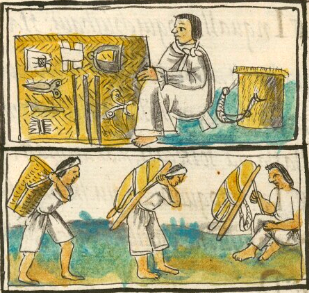pochtecatl (FCbk10f29v)
This iconographic example, featuring a merchant (pochtecatl), is included in this digital collection for the purpose of making comparisons with related hieroglyphs. The term selected for this example comes from the text on the page previous to the page with the image in the Digital Florentine Codex. There is no gloss, per se. This example shows a merchant (a pochtecatl, with plural being pochteca/pochtecah) sitting on a woven mat (petlatl) by his wares that are for sale, presumably in a market. The contextualizing image shows a large container with an attached tumpline resting behind him. This is because the pochtecatl is a traveling merchant who carries his goods sometimes long distances. The keywording team at the DFC have identified some of the goods that are for sale, including a stirrup (tepoztlaczaloni) one with use when riding a horse, a pair of scissors (tlateco tixeras or tlatequiloni), and a small woman’s blouse (huipilli).
Stephanie Wood
Some of the items this merchant has for sale show a relationship with a few glyphs in this collection, such as the metal spur that would be worn on a boot that would fit in a stirrup. A shoemaker’s scissors also appear here. And, of course, huipiles appear many times in this collection, which a Quick Search of huipilli will reveal easily. Another pochtecatl (on folio 41 recto) adds more merchandise, including quetzalli feathers, a necklace (cozcatl) with red and green beads, a lavish cloak (tilmatli), a Spanish shirt (camisa), and another huipilli. While many women made their own huipilli, some were apparently producing for the market, perhaps targeting women who were in a domestic labor situation where they did not have time to weave.
Stephanie Wood
puchtecatl
pochtecatl
Stephanie Wood
1577
Jeff Haskett-Wood
comercio, mercado, mercados, tianguis, vender, mercancías, tijeras, huipiles, estribo, estribos, objetos metálicos
pochteca(tl), a long-distance merchant, https://nahuatl.wired-humanities.org/content/pochtecatl
tepoztlaczaloni, a stirrup, https://nahuatl.wired-humanities.org/content/tepoztlaczaloni
tlatequiloni, a cutting instrument, https://nahuatl.wired-humanities.org/content/tlatequiloni
el comerciante
Stephanie Wood
Available at Digital Florentine Codex/Códice Florentino Digital, edited by Kim N. Richter and Alicia Maria Houtrouw, "Book 10: The People", fol. 29v, Getty Research Institute, 2023. https://florentinecodex.getty.edu/en/book/10/folio/29v/images/0 Accessed 10 September 2025.
Images of the digitized Florentine Codex are made available under the following Creative Commons license: CC BY-NC-ND (Attribution-NonCommercial-NoDerivs 4.0 International). For print-publication quality photos, please contact the Biblioteca Medicea Laurenziana ([email protected]). The Library of Congress has also published this manuscript, using the images of the World Digital Library copy. “The Library of Congress is unaware of any copyright or other restrictions in the World Digital Library Collection. Absent any such restrictions, these materials are free to use and reuse.”



